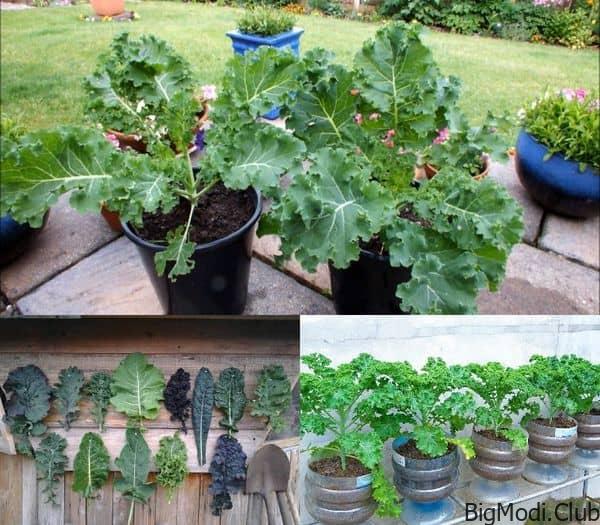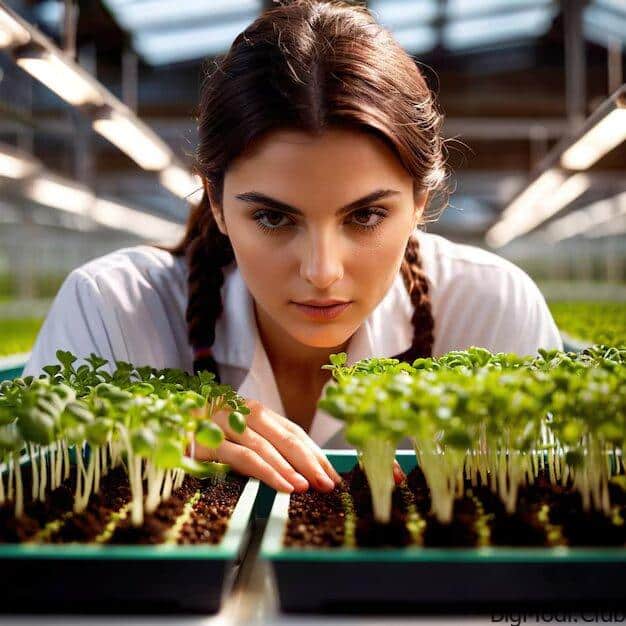Known for its impressive nutritional benefits and adaptability, kale can thrive in various environments with the right care. Whether you’re wondering how to grow kale in a garden bed or in pots, this comprehensive guide will cover everything you need to know to cultivate healthy kale plants.
How to Grow Kale involves understanding the best soil conditions, planting methods, and care routines to ensure robust growth. From preparing the soil and choosing between seeds or transplants to managing watering needs and addressing common problems, this guide will help you master the art of kale cultivation. Let’s dive into the essential steps and tips for successfully growing kale in different settings.
How to Grow Kale: A Comprehensive Guide
Kale is renowned for its rich nutritional profile and versatility in the kitchen. Whether you’re planting it in a garden bed or growing it in pots, kale thrives with the right care and conditions. This guide will walk you through everything you need to know about growing kale, from soil preparation to harvesting.
Soil Requirements and Preparation
Kale flourishes in fertile, well-drained soil enriched with organic matter. To ensure optimal growth, start by assessing your soil’s nutrient levels through a soil test. If the results indicate a need for improvement, incorporate fertilizer into the top 6 inches of soil. Aim to add no more than 1 inch of well-composted organic matter per 100 square feet to avoid over-fertilizing.
Planting Kale: Seeds or Transplants?
Kale can be grown from either seeds or transplants. If starting from seeds, plant them ¼-½ inch deep. Thin the seedlings when they develop 3-4 true leaves to avoid overcrowding. For transplants, wait until they have 4-6 mature leaves and a robust root system. Generally, it takes 5-6 weeks to grow transplants to this stage.
Spacing and Temperature
When planting kale, space the seedlings 12 inches apart in rows that are 2 feet apart. Kale prefers cooler temperatures, ideally below 75°F. Young plants can endure temperatures as low as 25°F, while mature kale is remarkably hardy and can withstand even colder conditions. For fall crops, choose early-maturing varieties and plant them 50-75 days before the expected harvest date.
Watering Kale
Proper watering is crucial for healthy kale growth. Water deeply and infrequently, aiming for 1-2 inches of water per week. Drip irrigation is ideal for conserving water and ensuring even moisture. Applying mulch can help retain soil moisture and reduce weed growth. Be cautious of moisture fluctuations, as they can cause the leaves to become tough and develop undesirable flavors.
Fertilization
To encourage vigorous growth, apply ½ cup of a nitrogen-based fertilizer (21-0-0) per 10 feet of row about 4 weeks after transplanting or thinning. Place the fertilizer 6 inches from the plants and water it into the soil to ensure even distribution.
Mulches and Row Covers
Utilize plastic mulches to conserve water and minimize weed growth. Fabric covers can protect seedlings from frost and insect pests. Organic mulches such as grass clippings, straw, and shredded newspaper help maintain soil temperature, reduce water stress, and control weeds.
Common Problems and Solutions
- Weeds: Manage them effectively using plastic or organic mulches.
- Insects: Aphids, cabbage worms, loopers, and flea beetles can be controlled with insecticides or other appropriate measures.
Harvesting Kale
Kale is ready to harvest when the leaves reach full size. Frosts can enhance the flavor of fall-planted kale. Store harvested kale at 32°F and 95% relative humidity for 2-3 weeks.
How to Plant Kale Seeds
Seed Treatment: Kale seeds do not require pre-sowing treatments such as soaking or stratification.
Direct Sowing in the Garden
Sow kale seeds 10mm deep and space them 40-60cm apart in rows 50-100cm apart. Keep the soil consistently moist, avoiding extremes of wet or dry conditions. Seeds typically germinate within 6-12 days at temperatures between 8-30°C. Protect young seedlings from pests and harsh weather until they are well-established.
Raising Seedlings
Use trays, punnets, or jiffy pots filled with high-quality seed-raising mix. Sow seeds 10mm deep, keeping the soil moist but not soggy. Germination occurs within 6-12 days at temperatures between 8-30°C. Transplant seedlings to the garden once they develop their first true leaves and reach 5-10cm in height. Space them 40-60cm apart in rows 50-100cm apart.
Temperature Considerations: Kale is a cool-season crop and may bolt in hot weather. Avoid sowing seeds or transplanting seedlings during warm temperatures to ensure successful growth.
How to Grow Kale in Pots
Container Size and Planting
Kale can thrive in pots, particularly dwarf and compact varieties like ‘Dwarf Blue Curled’ or ‘Winterbor.’ Choose pots that are at least 8-10 inches deep and 10-12 inches wide per plant. A large 5-gallon pot is ideal for providing ample space for root development.
Planting: Start planting kale in containers once the risk of frost has passed. Use well-draining potting soil and plant the kale at a depth slightly deeper than it was in the nursery pot. Ensure the pot has drainage holes to prevent waterlogging.
Watering and Feeding
Kale in pots needs frequent watering, especially in hot weather, as pots dry out quickly. Water deeply until excess water drains from the bottom. Consider using watering globes or self-watering planters to maintain consistent moisture.
Fertilize regularly with a balanced fertilizer, applying it when planting and continuing with a water-soluble fertilizer every two weeks. Nitrogen-rich fertilizers like fish emulsion are particularly beneficial during the growing season.
Light and Temperature
Kale prefers full sun but can tolerate light shade. Aim for growing temperatures around 65°F. In hotter climates, move pots to shadier locations to prevent stress and bolting.
Protection: Taller kale varieties may require staking for support. Use fine netting to protect plants from pests such as cabbage white butterflies and pigeons.
Growing Kale in Pots Indoors
Indoor Kale as a Houseplant
Imagine harvesting fresh kale without stepping outside, especially during winter’s chill. Growing kale indoors as a houseplant offers just that—convenience and a reliable supply of nutritious greens. Not only does this method provide a steady harvest, but it also serves as a backup if your outdoor plants face unexpected challenges.
Growing Methods
- Sprouts and Microgreens: For a quick and nutritious addition to your meals, you can grow kale seeds indoors as sprouts or microgreens. These tender greens are perfect for enhancing sandwiches, stir-fries, and rice bowls.
- Grow Lights: If you’re aiming for a continuous supply of salad greens, consider using grow lights. This setup allows you to cultivate kale indoors throughout late fall and early winter, ensuring a fresh supply of greens despite the weather outside.
- Sunny Windowsill: No grow lights? No problem. Kale can thrive on a sunny windowsill or in a sunroom, provided it gets ample light to support its growth.
Varieties
For indoor cultivation, curly kale varieties such as ‘Vates Blue’ and ‘Green Curls’ are particularly suitable. Their attractive, frilly leaves add a touch of greenery to your space, and they tend to produce sweeter, smaller leaves when grown indoors. Another great option is Lacinato kale, which works well as baby salad greens.
Potting and Planting
Start by choosing pots with drainage holes and filling them with an organic potting mix designed for vegetables. Sow kale seeds about a quarter inch deep, and keep the soil consistently moist using a mister. As seedlings grow, thin them out and transplant them to larger pots if needed to give them room to thrive.
Caring for Indoor Kale
Caring for indoor kale involves a few key practices:
- Watering: Regularly check your kale plants. Unlike ornamental houseplants, kale requires frequent attention. Ensure you water them deeply and keep the soil consistently moist.
- Fertilizing: Kale has high nitrogen needs. Feed your plants monthly with an organic liquid fertilizer to support robust growth.
- Pest Management: One of the benefits of indoor gardening is avoiding outdoor pests like cabbage moths. However, you should still monitor for common indoor pests.
Harvesting Indoor Kale
To enjoy the best flavor and promote continuous growth, harvest outer leaves from mature plants, leaving the inner leaves to continue developing. For baby kale, pick the leaves when they’re about four to five inches tall, focusing on the outer leaves to encourage regrowth.
Kale Water Requirements
Watering Frequency and Depth
Kale thrives with deep, infrequent watering. The goal is to maintain even soil moisture, ensuring the plants get the water they need without excess.
Water Amount
Kale generally requires one to two inches of water per week. This amount can vary depending on weather conditions and soil type.
Watering Method
Using drip irrigation is an efficient way to conserve water while keeping your kale well-hydrated.
Mulching
Mulch is your ally in maintaining soil moisture and suppressing weeds. Applying a layer of mulch helps keep the soil consistently moist and reduces the need for frequent watering.
Moisture Fluctuations
Consistent moisture is crucial. Fluctuating water levels can make kale leaves tough and affect their flavor. Aim for steady hydration to keep your kale tender and delicious.


